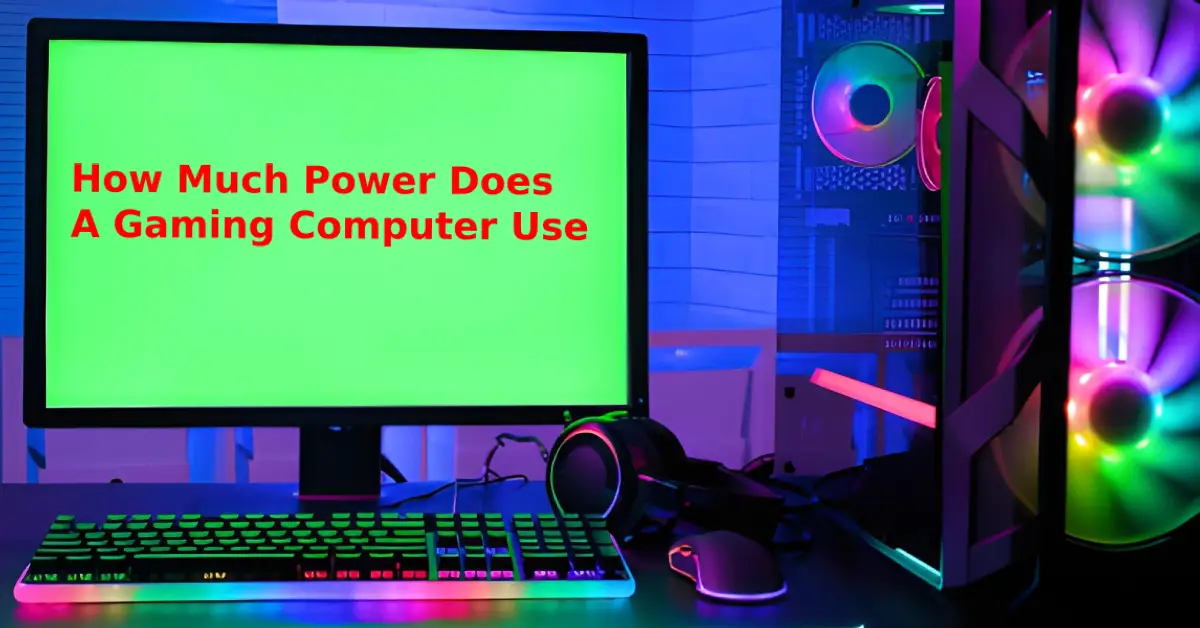How Much Electricity Does A Gaming PC Use? Cost Calculator

A gaming PC typically consumes between 300 and 500 watts per hour during active gameplay. That’s roughly 0.3 to 0.5 kilowatt-hours (kWh) every hour, or about 5 to 8 watt-minutes per second of use. Over the course of a day, gaming for three hours uses 0.9 to 1.5 kWh, which equals about $0.21 to $0.35 daily at an average U.S. electricity rate of $0.23 per kWh. That adds up to about $1.50 to $2.45 per week, $7.68 to $19.20 per month, and $92 to $230 per year—depending on your gaming habits and PC specifications.
According to a U.S. study by the Lawrence Berkeley National Laboratory, gaming computers account for only 2.5% of all PCs, yet they consume nearly 20% of total PC energy use, averaging about 1,400 kWh annually. The study confirms that gaming PCs are among the most energy-demanding household electronics, making it essential to track power draw and explore ways to improve efficiency.
| Gaming PC Timing | Power Use (kWh) | Cost at $0.23/kWh |
|---|---|---|
| 1 Hour | 0.3 – 0.5 kWh | $0.07 – $0.12 |
| 3 Hours (Daily Gaming) | 0.9 – 1.5 kWh | $0.21 – $0.35 |
| Per Week | 6.3 – 10.5 kWh | $1.50 – $2.45 |
| Per Month | 33 – 72 kWh | $7.68 – $19.20 |
| Per Year | 396 – 876 kWh | $92 – $230 |
How to Calculate Power Draw in A Gaming PC?
To calculate your gaming PC’s power draw, find its average wattage, convert it to kilowatt-hours (kWh), and multiply by your electricity rate.
For example, a 400-watt PC used for 3 hours consumes about 1.2 kWh, which costs roughly $0.28 per day at a U.S. rate of $0.23/kWh—around $8 per month or $100 per year.
Alternatively, use our gaming PC power draw calculator below.
Main Components
Enter your PC component power values.
Results
Which Components Draw Most Power in A Gaming PC?
The components that draw the most power in a gaming PC are compared in the table below.
| Component | Average Power Draw (Watts) | Low-End Estimate | High-End Estimate | Remarks |
|---|---|---|---|---|
| Graphics Card (GPU) | 250 | 200 | 350+ | Most power-hungry; spikes during gaming |
| CPU | 100 | 55 | 200 | Depends on cores, threads, and overclocking |
| Motherboard | 60 | 25 | 100 | Varies with features, ports, and lighting |
| Power Supply Unit (PSU) | 300 | 130 | 600 | Efficiency rating affects power loss |
| RAM | 4 | 2 | 5.5 | Minimal use; multiplies with more modules |
| Storage (HDD/SSD) | 5 | 0.6 | 9 | SSDs use less power than HDDs |
| Cooling Fans/Pumps | 6 | 1 | 15 | Includes both case fans and liquid cooling pumps |
Graphics Card (GPU)
The GPU, or graphics card, consumes the most electricity in a gaming PC. High-end cards like NVIDIA’s RTX or AMD’s Radeon series use between 200 and 350 watts when rendering complex graphics or running high frame rates. Overclocking or running multiple GPUs increases this draw dramatically—sometimes exceeding 400 watts under peak loads.
Central Processing Unit (CPU)
Your CPU handles all core game logic and background processes. A standard gaming processor uses 55 to 150 watts, but overclocked models can reach 200 watts. The more threads and cores you push, the more electricity it demands.
Motherboard
Though less obvious, the motherboard powers ports, chipsets, and voltage regulators. Depending on connected components, it typically draws 25 to 100 watts. RGB lighting and high-performance circuits raise this figure slightly.
Power Supply Unit (PSU)
The PSU converts wall electricity into usable power for your PC. Its own consumption varies between 130 and 600 watts, depending on system load and efficiency. An 80 Plus Gold or Platinum-rated PSU wastes less power as heat, improving efficiency.
Memory (RAM)
While RAM is a low consumer compared to GPU or CPU, multiple sticks or high-frequency kits still add up. Standard DDR4 or DDR5 modules use between 2 and 5.5 watts each.
Storage Drives
Solid-state drives (SSD) and hard drives (HDD) both consume minimal electricity. An HDD typically uses 6 to 9 watts, while an SSD stays between 0.6 and 3 watts, depending on activity level.
Cooling and Case Fans
Fans help keep components cool, but they draw additional power. A standard case fan uses 0.6 to 3 watts, and RGB or high-RPM fans might double that. Liquid cooling pumps add another 10–15 watts on average.
How to Reduce Power Consumption in A Gaming PC?
To reduce power consumption in a gaming PC, follow the tips below.
- Use an efficient power supply (PSU): Choose one with an 80 Plus Gold or Platinum rating to minimize energy loss.
- Enable power-saving settings: Activate sleep mode, hibernation, or GPU power management features when not gaming.
- Limit background apps: Close unused programs and services that keep your CPU and GPU active.
- Lower graphics settings: Reducing resolution or frame rates slightly cuts GPU workload and energy draw.
- Keep hardware clean: Remove dust and ensure proper airflow to prevent overheating and unnecessary power use.
- Upgrade outdated components: Newer CPUs and GPUs often perform better with less electricity.
- Undervolt the GPU or CPU: Safely lowering voltage reduces power draw without sacrificing performance.
- Use energy-efficient peripherals: Choose monitors, keyboards, and accessories with low standby power.
- Turn off RGB lighting: Disabling or dimming case and peripheral lighting saves several watts continuously.
- Shut down when idle: Power down the system when you’re not gaming instead of leaving it on standby.
How Much Energy Per Year Does a Computer Use?
A typical desktop computer uses around 200 to 500 kilowatt-hours (kWh) of electricity per year, depending on performance and usage. A gaming PC draws much more—usually between 1,200 and 1,400 kWh annually—while a laptop averages only 50 to 100 kWh per year. At an average U.S. electricity rate of $0.23 per kWh, that equals roughly $45 to $115 yearly for a regular desktop and about $275 to $320 for a gaming PC.
How much power does a gaming PC draw in 24 hours?
A gaming PC typically uses between 0.8 and 2.5 kilowatt-hours (kWh) of electricity every 24 hours, depending on how long and how intensely it’s used. A mid-range setup running for about three hours a day at 400 watts consumes around 1.2 kWh daily, costing roughly $0.18 to $0.70 per day at the U.S. average rate of $0.23 per kWh—or about $5 to $21 per month in added electricity costs.
How much energy does a gaming laptop draw?
gaming laptop typically draws between 200 and 300 watts per hour during active gameplay, depending on the GPU, CPU, and display brightness. Over a three-hour gaming session, that equals roughly 0.6 to 0.9 kilowatt-hours (kWh) of electricity. On a yearly scale, with regular use, a gaming laptop uses around 200 to 350 kWh per year—less than half the energy of a gaming desktop. At an average U.S. rate of $0.23 per kWh, that’s about $45 to $80 annually in electricity costs.
How much power does a gaming PC use in sleep mode?
A gaming PC in sleep mode draws about 1 to 10 watts of power, based on measurements from multiple hardware tests and energy-use studies. These low watt levels come from the system keeping memory active and maintaining minimal background functions. Even high-performance gaming desktops fall within this small range because the CPU, GPU, storage, and cooling stay inactive.

Mosaab Jamal Ahmed brings 12+ years of PC Hardware experience to the table. His journey began in 1998 with a Pentium 1 PC, igniting his lifelong fascination with computer hardware and video games. Over the years, Mosaab has honed his skills in upgrading and building gaming PCs. He has built dream gaming machines for multiple brands and local businesses throughout his career. Mosaab’s areas of expertise are building custom gaming PCs, in-depth PC hardware analysis, and PC hardware reviews.
